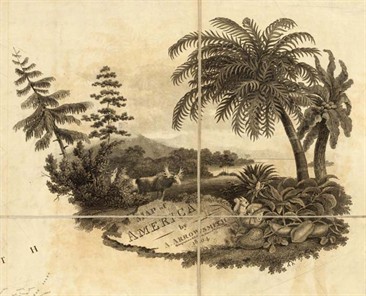David Thompson arrived in
the Americas as a teen-age boy apprenticed to the Hudson Bay
Company. This precocious lad was taught celestial navigation
by master at his trading post near Hudson's Bay. At 18,
Thompson made his first expedition to the Rocky Mountains and spent
the winter living with the family of a Cree chief. His
mastery of astronomy and map-making soon made him "the greatest
geographer of his day" in British America, and a peerless
cartographer.
(click here for more on Thompson)
Thompson would
go on to map most of the Canadian (and American) West, and it was
his work that established the 49th parallel that divided the two
countries. He also found the source of the Columbia
River.
No one knew the
western mountains better than Thompson. After spending
decades taking sun sights and painstakingly recording his
observations, Thompson produced a remarkably detailed map which he
labeled, simply, 'Map of the North-West Territory of the Province
of Canada from actual survey during the years 1792-1812.
Cartographic historian Carl L. Wheat has called this map "one of
the greatest maps ever drawn, and a magnificent cartographic
monument to its maker." Thompson's maps are Canadian national
treasures and are kept in the national archives in Ottawa,
Ontario.
Thompson was
probably the last to see the Indian civilizations of the high
plains in a condition of wholeness that existed prior to the
arrival of Lewis and Clark. When the Corps of Discovery
started up the Missouri River in 1804, they carried a copy of the
chart Thompson had made on his previous visit to the Mandan
Villages, seven years earlier. (click here for more)

They also carried the
most up-to-date map of North America that was available at the time
-- the Arrowsmith map (see other reference under 1795).
Arrowsmith's "New and Elegant Atlas", published in Philadelphia in
1795, drew heavily from information gathered by
Thompson. Lewis and Clark carried a map of the Missouri
to the Mandan Villages, drawn by John Evans, a Welshman, who
ascended the river with his boss, James Mackay, in 1787, when both
men were employed by the North West Company.
The
contributions of Thompson, Mackenzie, Evans, and Mackay, to the
Lewis and Clark expedition cannot be overestimated, but these men
are seldom mentioned in contemporary accounts of the famous
American explorers. Most of the notable geographic landmarks
between St. Louis and the Rocky Mountains, and along the West
Coast, had already been mapped by 1804. Mackay, in
fact, had been a primary source of information for the Spanish, who
made a map highlighting northern rivers and the features of the
British fur-trading network in Canada. The gap in their
knowledge is represented in a Spanish map drawn in 1785 that shows
a narrow corridor of land running north and south between the west
slope of the Rocky Mountains and the great Cascade range, to the
west. Everything in between is marked 'unknown lands, with
the following notation: "The black line on this map marks the line
between the United States and Canada as observed by Mr. Mackay
during his journeys of discovery for the English fur trade in
1784.
The original Spanish
map was prepared to assist the Spanish explorer Jean Baptise
Truteau, when he led an expedition up the Missouri in 1794, a
decade before Lewis and Clark. (click here
for more)
His expedition gives an
accurate description of a river that joins the Missouri from the
south, above the 'great bend near the Canadian border, which he
labeled as The Rock River. Today we know it as the
Yellowstone.
Related People
Related Places